Palace to Temple with a Little Entertainment
From Tenmabashi to Abeno along the Kumano Kodo Kii-ji route
It’s almost New Year in Japan, so a Happy New Year to all my readers! I wish you the best of luck for 2025, and thank you for reading Walking Across Japan.
The City (continued) 市Osaka Museum of History is outwardly disappointing, set as it is within gleaming glass next to TV studios, but inside it is superb. The top floor has a stunning video that recreates the Naniwa Palace settlement, the outline remains of which are visible from the windows of the museum. The settlement, whose Chinese characters meant ‘difficult waves’, was probably the first laid out on the Japanese islands using the grid-style urban design that had arrived from China. The entrance to the compound was through twelve vermilion-lacquered gateways, the forerunner of a design that would spread throughout Japan in shrines.
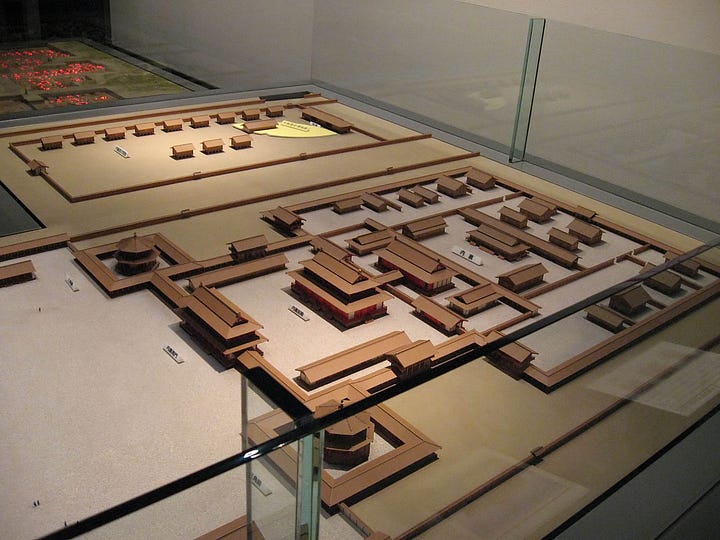
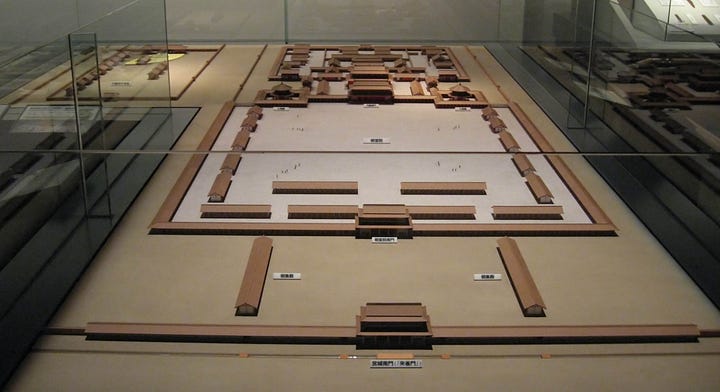
Naniwa became the seat of the imperial government in 645 CE, the palace construction was completed by 652 CE, but the stunning vermilion city would only remain the capital until 694 when a new capital emerged on the Nara plain. Never again would the capital be located here, but Naniwa’s location at the mouths of the Yamato and Yodogawa rivers would ensure its continued importance for centuries to come.
The other floors of the museum marked this shift from administrative to commercial importance. There are displays and volunteers explaining about the money used as Naniwa became Osaka and a key trading centre. One of the volunteers joked when I told him where I was from, that the British had stolen lots of Japanese gold — at least, I think he was joking.
As Osaka’s commercial importance grew, so too did its entertainment industry. A large part of one floor is devoted to the rise of the Shinsaibashi entertainment area around the newly-constructed Dotombori Canal. Large theatres emerged during the eighteenth century; these would have provided entertainment not just for the merchant families and tradesmen, but for visiting pilgrims too. Ogin wouldn’t have had much time for the entertainment, and when the abdicated emperors and powerful clan members passed this way, there was merely a narrow strip of merchant housing surrounded by fields and swamp leading to the new temple at Tennoji.
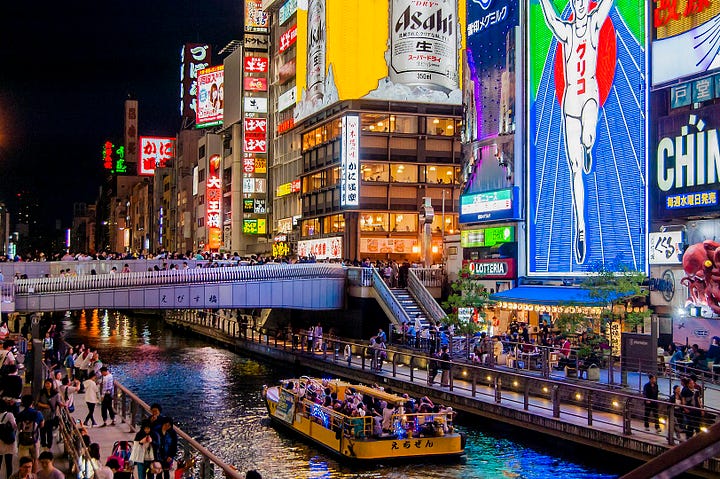
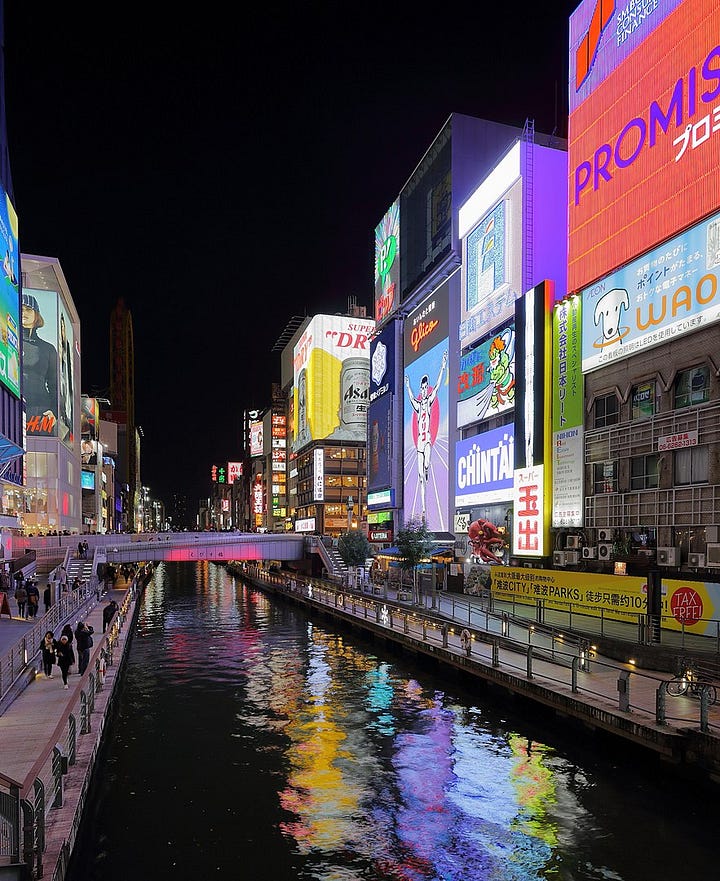
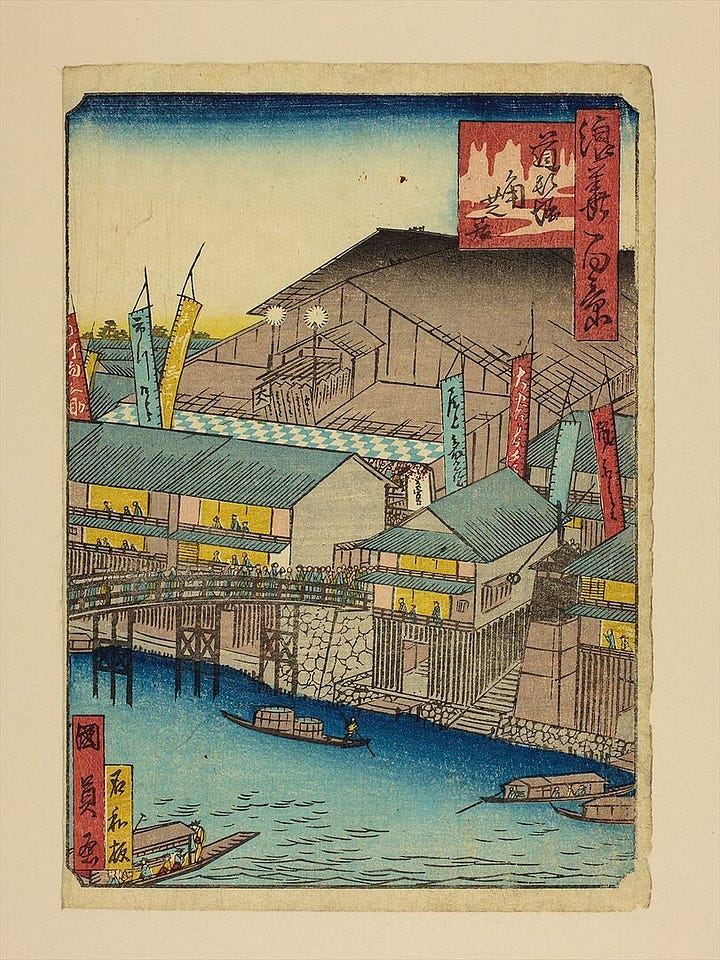
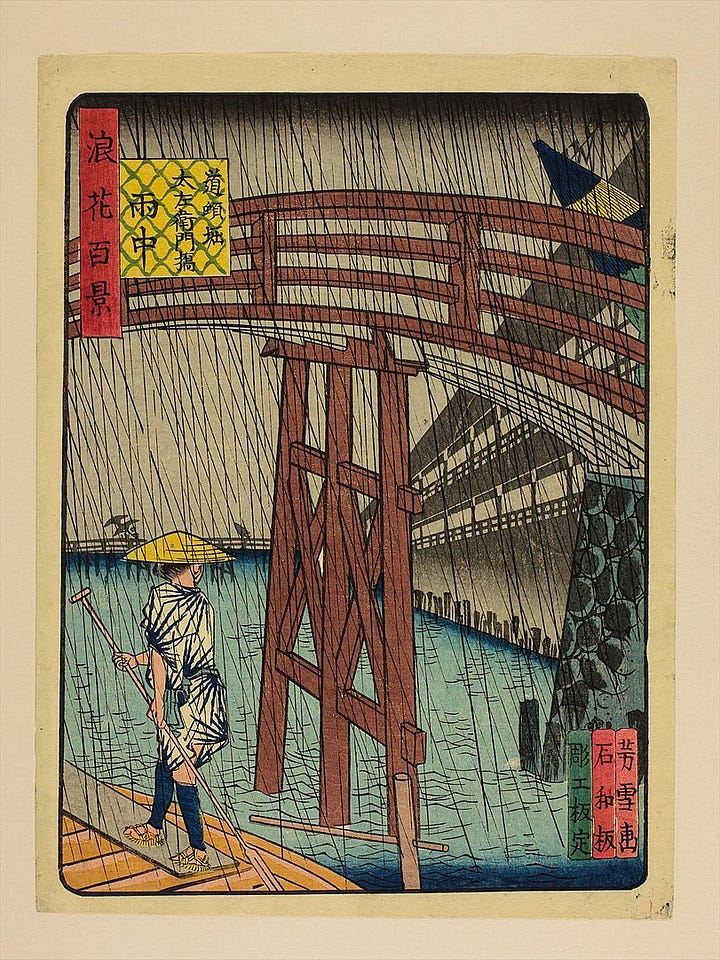
What Ogin would have seen however, towering above the eaves of the daimyo warehouses and tightly-packed merchant areas, was the white and grey donjon (keep) of Osaka Castle. Construction of this layered edifice was started in 1583 by Toyotomi Hideyoshi as he attempted to cement his power following his victory over Oda Nobunaga. Throughout the late 1500s these two rivals had attempted to unify and take over Japan. Finally, Nobunaga committed suicide, and after a victory in 1582 Hideyoshi effectively became Nobunaga’s successor, winning control of his rival’s lands.
But Hideyoshi’s triumph was to prove short-lived. A new power was emerging — Tokugawa Ieyasu. Hideyoshi’s successor, Hideyori proved unable to hold off the encroaching power of Tokugawa after his victory at Sekigahara in 1600. In 1615 Hideyori committed suicide with his mother as Osaka Castle was burning down around them — Tokugawa’s forces had entered the castle following the final battle of the Summer War of that year.
In 1620 rebuilding work started on Osaka Castle. At around the same time, a network of canals were being constructed that would expand Osaka from a narrow strip to a teeming metropolis that extended right to the sea. Along the banks of one of these canals — the Dotombori, an entertainment area of theatres and brothels emerged. This is the world Ogin would have seen as she passed through – an over-crowded coastal city festering with gangs and teetering on the brink of rebellion. Rival ‘fire-fighting’ gangs competed to protect their patch, pulling down their opponents’ houses to create supposed fire-breaks, while bands of samurai retainers with little to do roamed the streets. Meanwhile, complaints over the price of rice led to several outbreaks of rioting. The Shogunate was on the edge of collapse — and in cities like Osaka, this was obvious.
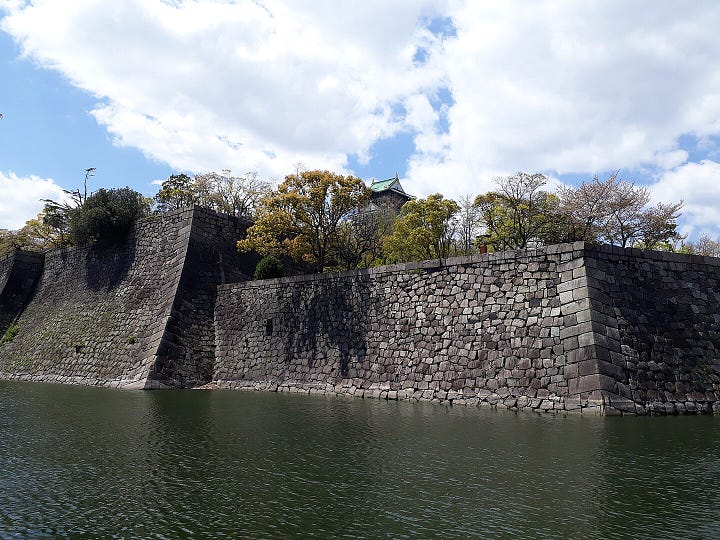
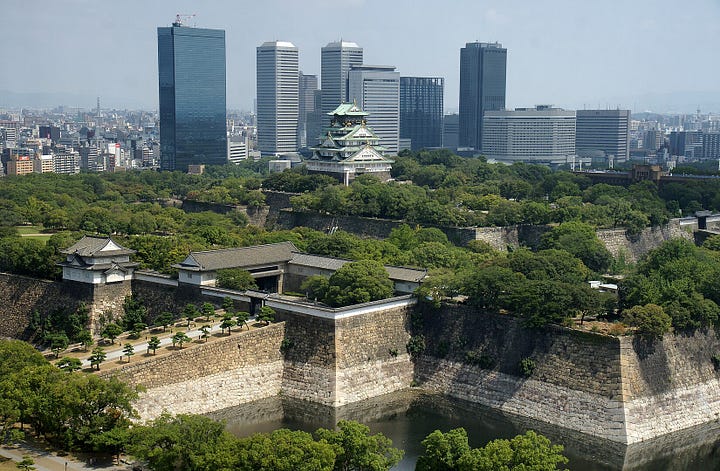
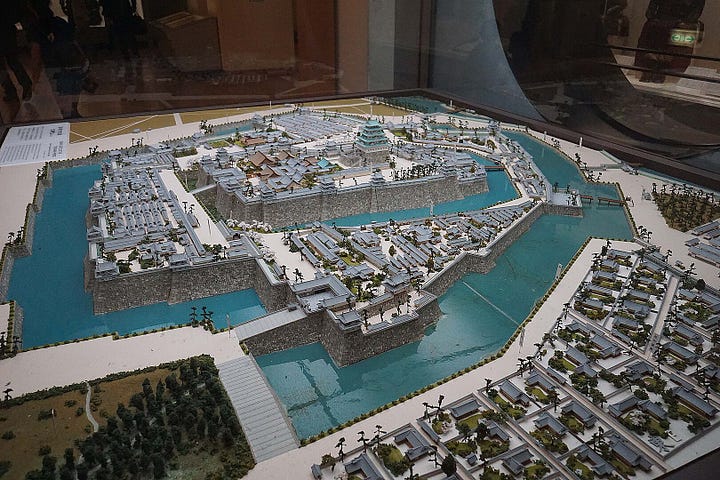
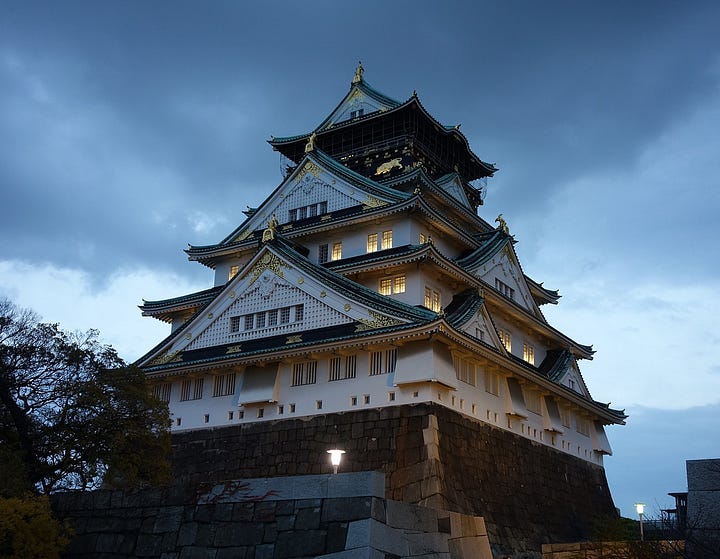
The current Osaka Castle is actually a concrete reconstruction, the original having burned down again during World War Two. The castle itself looks pretty good — it’s not obviously made of concrete, but the perimeter towers overlooking the moat look like concrete sheds with a fancy roof stuck on top. It does have an elevator, but it’s on the inside, not ruining the Shogunate-feel on the outside (looking at you Nagoya Castle).
市
Love hotels and temples are found close together for a very good reason. Pilgrimages were one of the few times in life when common people could escape the social restrictions of their home village. Their spiritual appetite satisfied at the temples, pilgrims were free to pursue rest or more energetic pursuits at the lodging houses that were erected to satisfy these needs. These lodging houses are the predecessors to today’s love hotels.
And now, I cut a straight line through just such a district. The car parks are typically under the hotel and in the car park of one hotel I could see a young couple leaving, made headless by the flapping plastic curtain that helped shield the cars’ identities. As if to disprove the idea that such hotels are only frequented by the young, at another hotel I spotted a couple at least in their sixties walking out of the exit door, which is situated away from the entrance to reduce embarrassment.
Meanwhile, the heat, smell of incense and elephant statues gave the temples I passed through on this section a distinctly Indian air. In one, a temple assistant, eager to practice his English welcomed me to his temple, as though I had specially selected it. But, I was merely going through — in through the north entrance and out through the south exit.
I discovered, among the office blocks and modern shops, two streets of old houses – some of those not coloured pink on the World War Two map in the history museum. In one of these was a tea house so discreet that I almost missed it. The dark wooden entrance hall had shelves crowded with fashionably artistic trinkets and books that had been well-thumbed a long time ago.
Leaving my shoes behind for the raised tatami area, I sat on a cushion, sipping my tea and eating an exquisite dark honey dessert. At the back of the tiny courtyard garden I spied a stoat beneath the bamboo fence, rapid slinks through the weeds, and it was gone.
市I could smell Shi-Tennoji temple before I found it. This is one of Japan’s oldest temples — its construction was ordered in by Shotoku Taishi (a prince) in 593 CE. It was Shotoku Taishi who began the process of introducing Buddhism to Japan. A prince of the Yamato family, the family which is thought to give the origins to Japan’s Imperial line, Shotoku Taishi felt that Buddhism would help extend his family’s control over the Japanese archipelago. After victories over his non-Buddhist foes, Shotoku Taishi decided to erect the temple at Shi-Tennoji to honour the Four Heavenly Kings (Buddhist devas who guard each of the four cardinal directions). These kings were thought to provide protection for the state. At the west gate of Shi-Tennoji, large crowds of commoners would gather hoping to obtain grace from the Amida Buddha. The west gate also afforded an excellent view to the setting sun and the Inland Sea. For these pilgrims, the setting sun helped to remind them of the Buddhist Western Paradise. Now the view to the sea is blocked by towering department stores and apartments. The area around Shi-Tennoji expanded to help cater to these pilgrims, both the upper-class seeking protection for their newly-emerging state, and the lower classes looking for salvation and relief from the trials of their difficult lives.
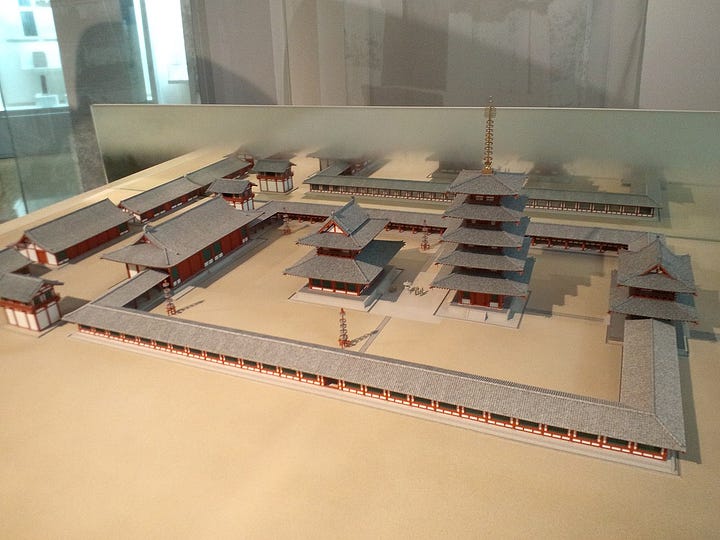
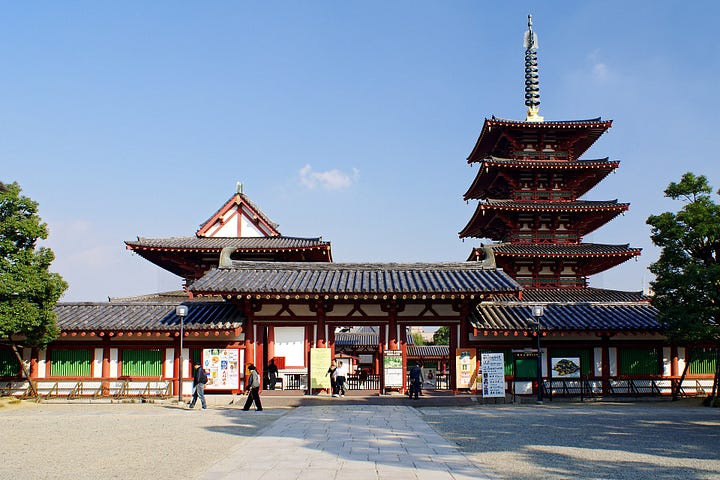
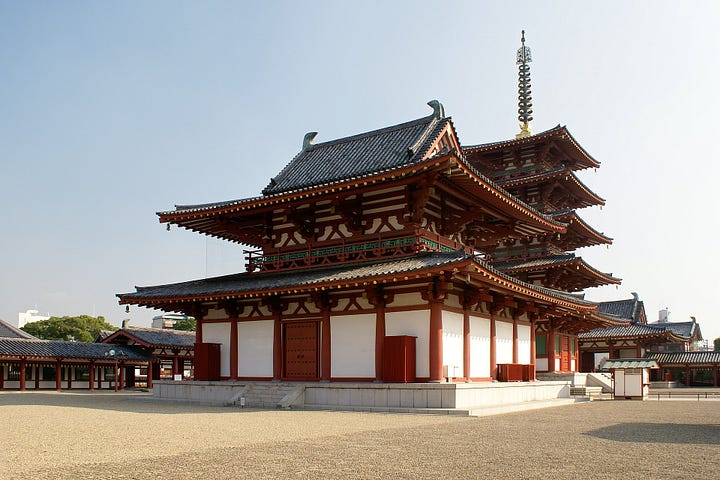
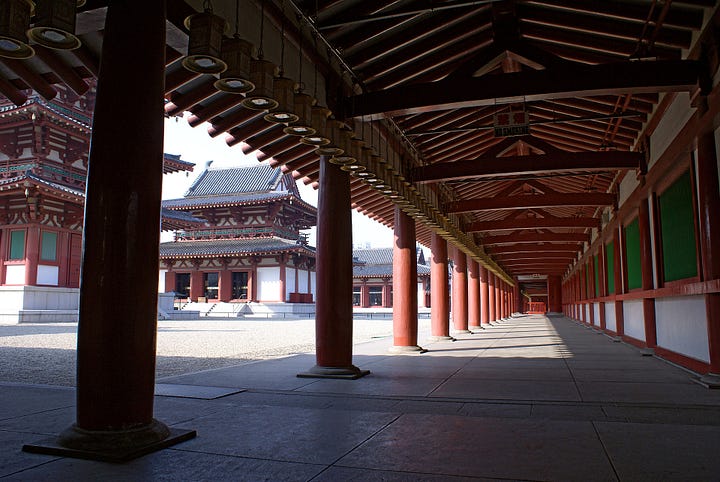
I left the department stores and block-like railway stations of Tennoji and entered the crowded shopping streets of Abeno. Cyclists weaved among the crowds of pedestrians. In Japan you develop a sixth sense to the approach of a cyclist from behind, but the first few weeks here are hell as you are continually clipped by speeding schoolboys, stately but wobbly obasans, and housewives with toddlers when you decide to change direction while walking.





Very good and informative as usual.
Though I have lived in Japan for 32 years, I'd never been to Osaka until this year, so last week I spent two days there with my wife and I found it quite interesting.
On the first day, we did a tiny portion of the walk along the Ogawa that you described in your recent story.
The highlights for us where Sumiyoshi Taisha, Senkoji (全興寺), and the Osaka Museum of Housing and Living.
This is all very interesting! I wish I could remember everything though.